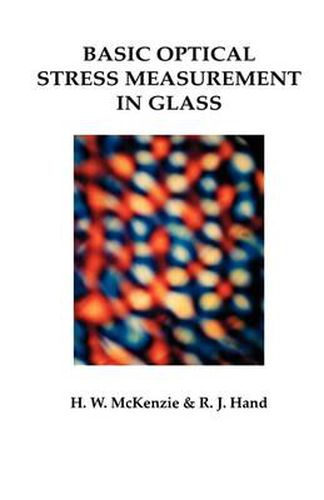Readings Newsletter
Become a Readings Member to make your shopping experience even easier.
Sign in or sign up for free!
You’re not far away from qualifying for FREE standard shipping within Australia
You’ve qualified for FREE standard shipping within Australia
The cart is loading…






During the manufacture of all glass products, both temporary and residual stresses develop. Such stresses arise as a consequence of the manufacturing processes and for proper process control to be exercised it is necessary to be able to quantify these stresses. The optical method of experimental stress analysis, known as photoelasticity, has been used very effectively in the evaluation of the stresses occurring in structures of varying complexity, together with their components, when subjected to specified loading conditions. As the photoelastic technique requires materials that are both transparent and birefringent and many glasses exhibit these properties, this method of analysis can be used to determine the stresses in glass products. There are many texts dealing with photoelastic analysis and its applications, but they are not aimed specifically at the assessment of residual stresses in glasses. This publication offers a practical guide providing information on the various optical arrangements and interpretation of results from typical plant apparatus, it is of general interest to those making stress measurements within the glass industry. There is a survey of the available methods and an outline of the application of these techniques to the various measurements which have to be made as a matter of course during production. In addition, the relevant theory is discussed in a non-mathematical manner to provide readers with the background knowledge of how these techniques work, as well as an appreciation of the limitations of the methods when applied to glass products. Users of photoelastic techniques in the glass industry, both in day-to-day quality assurance and in more specialist fault-finding applications, will find the information in this book relevant to their needs and that it provides an improved understanding of the measurements being made.
$9.00 standard shipping within Australia
FREE standard shipping within Australia for orders over $100.00
Express & International shipping calculated at checkout
During the manufacture of all glass products, both temporary and residual stresses develop. Such stresses arise as a consequence of the manufacturing processes and for proper process control to be exercised it is necessary to be able to quantify these stresses. The optical method of experimental stress analysis, known as photoelasticity, has been used very effectively in the evaluation of the stresses occurring in structures of varying complexity, together with their components, when subjected to specified loading conditions. As the photoelastic technique requires materials that are both transparent and birefringent and many glasses exhibit these properties, this method of analysis can be used to determine the stresses in glass products. There are many texts dealing with photoelastic analysis and its applications, but they are not aimed specifically at the assessment of residual stresses in glasses. This publication offers a practical guide providing information on the various optical arrangements and interpretation of results from typical plant apparatus, it is of general interest to those making stress measurements within the glass industry. There is a survey of the available methods and an outline of the application of these techniques to the various measurements which have to be made as a matter of course during production. In addition, the relevant theory is discussed in a non-mathematical manner to provide readers with the background knowledge of how these techniques work, as well as an appreciation of the limitations of the methods when applied to glass products. Users of photoelastic techniques in the glass industry, both in day-to-day quality assurance and in more specialist fault-finding applications, will find the information in this book relevant to their needs and that it provides an improved understanding of the measurements being made.